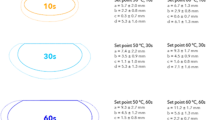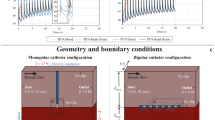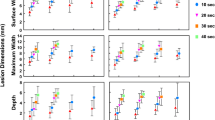Abstract
Sequences of energy application to multiple electrodes and a study of ablation duration with distal tip and multi-electrode ablations were explored with a radiofrequency controller that distributes energy from a generator to up to 4 electrodes with various duty cycles. In vitro ablations were performed on bovine left ventricle in circulating blood and lesions in goats were performed to verify the in vitro results.
All of the ablation sequences with simultaneous electrode activation of contiguous electrodes resulted in deeper lesions than those created in sequence. There was also no scalloping of the lesion if contiguous electrodes were activated simultaneously. During all distal tip ablations, lesion volume and depth was greater after 3 minutes of energy delivery than after 1 minute, but did not increase from 3 minutes to 5 minutes. There was a significant increase in multi-electrode ablation lesion depth with each additional minute in the ablation cycle. The in vivo ablations verified these results at 120 and 300 second ablations. Pulsed energy distal tip ablations resulted in deeper lesions than continuous only if power amplitudes over 50W were employed.
In conclusion, contiguous electrodes in simultaneous use create lesions that resemble one large lesion rather than two lesions positioned next to each other. Multi-electrode ablation lesions continue to grow at ablation durations of up to 5 minutes compared to distal tip lesions which reach steady-state between 1 and 3 minutes. Pulsed energy delivery to distal tips may result in deeper lesions than conventional if high powers are employed.
Similar content being viewed by others
References
Cosio FG, Lopez-Gil M, Goicolea A, Arribas F, Barroso JL. Radiofrequency Ablation of the Inferior Vena Cava-Tricuspid Valve Isthmus in Common Atrial Flutter. Am J Cardiol 1993;71:705–709.
Fischer B, Jais P, Shah D, Chouairi S, Haissaguerre M, Garrigues S, Poquet F, Gencel L, Clementy J, Marcus FI. Radiofrequency Catheter Ablation of Common Atrial Flutter in 200 Patients. J Cardiovasc Electrophys 1996;7:1225–1233.
Fischer B, Haissaguerre M, Garrigues S, Poquet F, Gencel L, Clementy J, Marcus FI. Radiofrequency Catheter Ablation of Atrial Flutter in 80 Patients. J Amer Coll Cardiol 1995;25:1365–1372.
Chen SA, Chiang CE, Wu TJ, Tai CT, Lee SH, Cheng CC, Chiou CW, Ueng KC, Wen ZC, Chang MS. Radiofrequency Catheter Ablation of Common Atrial Flutter: Comparison of Electrophysiologically Guided Focal Ablation Technique and Linear Ablation Technique. J Amer Coll Cardiol 1996;27:860–868.
Wen ZC, Chen SA, Tai CT, Chiang CE, Lee SH, Chen YJ, Yu WC, Huang JL, Chang MS. Temperature Monitoring in Radiofrequency Catheter Ablation of Atrial Flutter Using the Linear Ablation Technique. J Cardiovasc Electrophys 1996;7:1050–1057.
Swartz JF, Pellersels G, Silvers J, Patten L, Cervantez D. A catheter-based curative approach to atrial fibrillation in humans. (Abstract) Circulation 1994;90:I335.
Haissaguerre M, Gencel L, Fischer B, Le Metayer P, Poquet F, Marcus FI, Clementy J. Successful catheter ablation of atrial fibrillation. J Cardiov Electrophys 1994;5:1045–1052.
Mitchell MA, McRury ID, Haines DE. Linear Atrial Ablations in a canine model of chronic atrial fibrillation: Morphological and Electrophysiological Observations. Circulation 1998;97:1176–1185.
Elvan A, Pride HP, Zipes DP. Replication of the “maze” procedure by radiofrequency catheter ablation reduces the ability to induce atrial fibrillation. (Abstract) PACE 1994;17:774
Avitall B, Hare J, Mughal K, Silverstein E, Krum D, Natale A, Deshpande S, Dhala A, Akhtar M. Ablation of atrial fibrillation in a dog model. (Abstract) J Amer Coll Card 1994;484:276
Panescu D, Fleischman SD, Whayne JG, Swanson DK. Contiguous lesions by radiofrequency multielectrode ablation. (Abstract) Proc. 17th Int'l IEEE Conf Eng Biol Soc, 1995:275-276.
McRury ID, Haines DE. Efficacy of multiple ring and coil electrode radiofrequency ablation catheters for the creation of long linear lesions in the atria. Med Eng & Phys 1998;20:551–557.
Haines DE, Langberg JJ, Lesh MD, Leon AR, Mitchell MM, DeLurgio DB. Catheter ablation of atrial fibrillation using the multiple electrode catheter ablation (MECA) System: Preliminary clinical trial results. (abstract) PACE 1998;21:832.
Leitch JW, Klein G, Yee R, Guiraudon G. Sinus node-atrioventricular node isolation: long-term results with the “corridor” operation for atrial fibrillation. J Amer Coll Card 1991;17:970–975.
Iesaka Y, Takahashi A, Goya M, Yamane T, Tokunaga T, Amemiya H, Fujiwara H, Nitta J, Nogami A, Aonuma K, Hiroe M, Marumo F, Hiraoka M. High energy radiofrequency catheter ablation for common atrial flutter targeting the isthmus between the inferior vena cava and tricuspid valve annulus using a super long tip electrode. PACE 1998;21:401–409.
Jais P, Haissaguerre M, Shah DC, Takahashi A, Hocini M, Lavergne T, Lafitte S, Le Mouroux A, Fischer B, Clementy J. Successful irrigated-tip catheter ablation of atrial flutter resistant to conventional radiofrequency ablation. Circulation 1998;98:835–838.
Cheema AN, Grais IM, Burke JH, Inbar S, Kadish AH, Goldberger JJ. Late Recurrence of Atrial Flutter Following Radiofrequency Catheter Ablation. PACE 1997;20(part I):2998–3001.
Mitchell MA, McRury ID, Everett TH, Li H, Mangrum JM, Haines DE. Morphological and physiological characteristics of discontinuous linear atrial ablations during atrial pacing and atrial fibrillation. J Cardiovasc Electrophysiol 1999;10:378–386.
Grumbrecht S, Neuzner J, Pitschner HF. Interrelation of tissue temperature versus flow velocity in two different kinds of temperature controlled radiofrequency energy applications. J Intervent Card Electrophys 1998;2:211–219.
Haines DE, Watson DD, Verow AF. Electrode radius predicts lesion radius during radiofrequency energy heating. A validation of a proposed thermodynamic model. Circ Res 1990;67:124–129.
Whayne JG, Nath S, Haines DE. Microwave Catheter Ablation of Myocardium In Vitro: Assessment of the Characteristics of Tissue Heating and Injury. Circulation 1994;89:2390–2395.
Haines DE. The biophysics of radiofrequency catheter ablation in the heart: The importance of temperature monitoring. PACE 1993;16:586–591.
Haines DE, Verow AF. Observations on electrode-tissue interface temperature and effect on electrical impedance during radiofrequency ablation of ventricular myocardium. Circulation 1990;82:1034–1038.
Chang RJ, Stevenson WG, Saxon LA. Increasing catheter ablation lesion size by simultaneous application of radiofrequency current to two adjacent sites. Amer Hrt J 1993;125:1276–1284.
Anfinsen OG, Kongsgaard E, Foerster A, Aass H, Amlie JP. Radiofrequency current ablation of porcine right atrium: increased lesion size with bipolar two catheter technique compared to unipolar application in vitro and in vivo. PACE 1998;21:69–78.
Mackey S, Thornton L, He DS, Marcus FI, Lampe LF. Simultaneous multipolar radiofrequency ablation in the monopolar mode increases lesion size. PACE 1996;19:1042–1048.
Sharma PP, He DS, Bosnos MJ, Marcus FI. A comparison of sequential with simultaneous delivery of RF energy application at multiple electrodes to produce linear continuous lesions. (abstract) Circulation 1997;96:3220.
Epstein MR, Knapp LD, Martindill M, Lula JA, Triedman JK, Calkins H, Huang SK, Walsh E, Saul JP. Embolic complications associated with radiofrequency catheter ablation. Atakr Investigation group. Am J Cardiol 1996;77:655–658.
Author information
Authors and Affiliations
Rights and permissions
About this article
Cite this article
McRury, I.D., Diamond, S., Falwell, G. et al. The Effect of Ablation Sequence and Duration on Lesion Shape Using Rapidly Pulsed Radiofrequency Energy Through Multiple Electrodes. J Interv Card Electrophysiol 4, 307–320 (2000). https://doi.org/10.1023/A:1009898504174
Issue Date:
DOI: https://doi.org/10.1023/A:1009898504174




